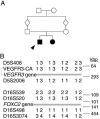Mutations in the transcription factor gene SOX18 underlie recessive and dominant forms of hypotrichosis-lymphedema-telangiectasia
- PMID: 12740761
- PMCID: PMC1180307
- DOI: 10.1086/375614
Mutations in the transcription factor gene SOX18 underlie recessive and dominant forms of hypotrichosis-lymphedema-telangiectasia
Abstract
Hereditary lymphedema is a developmental disorder characterized by chronic swelling of the extremities due to dysfunction of the lymphatic vessels. Two responsible genes have been identified: the vascular endothelial growth factor receptor 3 (VEGFR3) gene, implicated in congenital lymphedema, or Milroy disease, and the forkhead-related transcription factor gene FOXC2, causing lymphedema-distichiasis. We describe three families with an unusual association of hypotrichosis, lymphedema, and telangiectasia. Using microsatellite analysis, we first excluded both VEGFR3 and FOXC2 as causative genes; we then considered the murine ragged phenotype, caused by mutations in the Sox18 transcription factor, as a likely counterpart to the human disease, because it presents a combination of hair and cardiovascular anomalies, including symptoms of lymphatic dysfunction. Two of the families were consanguineous; in affected members of these families, we identified homozygous missense mutations in the SOX18 gene, located in 20q13. The two amino acid substitutions, W95R and A104P, affect conserved residues in the first alpha helix of the DNA-binding domain of the transcription factor. In the third family, the parents were nonconsanguineous, and both the affected child and his brother, who died in utero with hydrops fetalis, showed a heterozygous nonsense mutation that truncates the SOX18 protein in its transactivation domain; this substitution was not found in genomic DNA from either parent and hence constitutes a de novo germline mutation. Thus, we show that SOX18 mutations in humans cause both recessive and dominant hypotrichosis-lymphedema-telangiectasia, suggesting that, in addition to its established role in hair and blood vessel development, the SOX18 transcription factor plays a role in the development and/or maintenance of lymphatic vessels.
Figures




References
Electronic-Database Information
-
- GenBank, http://www.ncbi.nlm.nih.gov/Genbank/ (for SOX18 coding sequence [accession number NM_018419] and SOX18 protein [NP_060889])
-
- Mouse Genome Informatics, http://www.informatics.jax.org/
-
- National Center for Biotechnology Information, http://www.ncbi.nlm.nih.gov/ (for Entrez Map View)
-
- Online Mendelian Inheritance in Man (OMIM), http://www.ncbi.nlm.nih.gov/Omim/ (for Milroy disease, lymphedema-distichiasis, lymphedema-cholestasis, lymphedema-microcephaly-chorioretinopathy, and Noonan syndrome)
References
-
- Berta P, Hawkins JR, Sinclair AH, Taylor A, Griffiths BL, Goodfellow PN, Fellous M (1990) Genetic evidence equating SRY and the testis-determining factor. Nature 348:448–450 - PubMed
-
- Chitayat D, Kalousek DK, Bamforth JS (1989) Lymphatic abnormalities in fetuses with posterior cervical cystic hygroma. Am J Med Genet 33:352–356 - PubMed
Publication types
MeSH terms
Substances
Associated data
- Actions
- Actions
- Actions
- Actions
- Actions
- Actions
LinkOut - more resources
Full Text Sources
Other Literature Sources
Medical
Molecular Biology Databases
Research Materials
Miscellaneous

